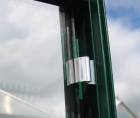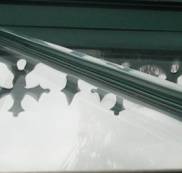Categories
Calendars
Guides
Reviews
Archive
Gallery
Articles
Ask Our Gardening Expert
TOPICS IN SELECTING GREENHOUSES
There is no choice and really no reason
to select a different type of glass unless you plan to have a very large
greenhouse for commercial purposes. There is variety and a true choice in the size of the glass panels.
The larger the size of the panes the better the light transmission which
is a benefit.
The disadvantage of larger panes is the heat loss is
increased and therefore heating costs are higher. One further
disadvantage of large panes of glass is that the cost of replacing a
broken pane will be higher. None of these factors are critical, so we
wouldn't really recommend making the pane size a key factor in your
choice of garden greenhouse. Other considerations with glass are that it is a good transmitter of
light (typically 94% of light goes through glass) which is the good news.
The bad news is that it is a bad transmitter of heat which means the
inside of a glass greenhouse can get very hot very quickly with
disastrous results for some plants. Glass is also very heavy compared to
the materials below which means the frame has to be stronger (and
therefore more expensive) and packing costs are higher. Plastics, Polycarbonates and Other Glazing Fibreglass / Polycarbonate Sheet The most common of these are acrylic and
polycarbonate double (sometimes triple) glazed sheets with excellent heat
retaining properties. These sheets perform at least as well as glass for
light transmission, although they do deteriorate with age. This material
is far less liable to breakage and very easy to form into curved
sections. These really are an excellent alternative to glass, especially
if children are liable to be in the same area as your greenhouse. Twin
wall or double glazed polycarbonate has a light transmission of around
85%, single wall polycarbonate has a light transmission even better than
glass, around 96%. Fibreglass has much the same properties as polycarbonate, but they
turn yellow much quicker and are therefore more costly in the long
run. Polythene Surprisingly, polythene is very good at transmitting
light because it diffuses it, spreading it more evenly round the
greenhouse. Previous problems with polythene tearing appear to have been
solved with new methods of securing it to the frame. The main problem
with polythene is that it is always being damaged by the suns rays. This
slowly reduces it's light transmission qualities and causes the material
age. One other key disadvantage with polythene is that condensation gathers
on the inside of the greenhouse which attracts dirt and makes it more
likely to encourage plant diseases. Some types of polythene greenhouse
are treated to help the moisture disperse but this does not seem to be
100% satisfactory. Methods of Securing Glass
The most commonly used glazing method is simply holding the glass in
place on a plastic strip and securing it there with metal clips at
various intervals along the frame. See the top picture on the left (click
picture to enlarge). This works fine in most cases and is
long-lasting. In areas exposed to high winds however, the clips may not
be strong enough and it is necessary to secure the glass in place with
with a continuous strip of metal - commonly referred to as bar-capping or
edge ridging. See the bottom picture on the right (click picture
to enlarge). Remember, in high winds the loss of one single pane of a greenhouse will
let the wind in which will destroy all the panes of glass in a few
seconds.
The Future
Glass Type and Pane Size
Almost all glass-glazed garden greenhouses for the amateur are made from
glass standard to your country and this differs slightly from country to
country.
There is now a very wide choice of alternatives to glass as glazing
material for a garden greenhouse. Many of these are beyond the scope of this
article, but two of the more popular alternatives are noted below:
If you buy a second hand glass greenhouse the glass may well be
secured by seating it on a bed of putty and held in place by nails. This
method is not commonly used nowadays because the putty deteriorates and
cracks. Treat a greenhouse of this type with caution.

Greenhouse glazing methods have changed very slowly over the years.
It seems that the polycarbonate sheets are the way forward. Triple glazed
polycarbonate retains the heat extremely well and the light transmission
is excellent. Polycarbonate also has the advantage that it is stronger
than glass or plastic, making it less vulnerable to damage.
